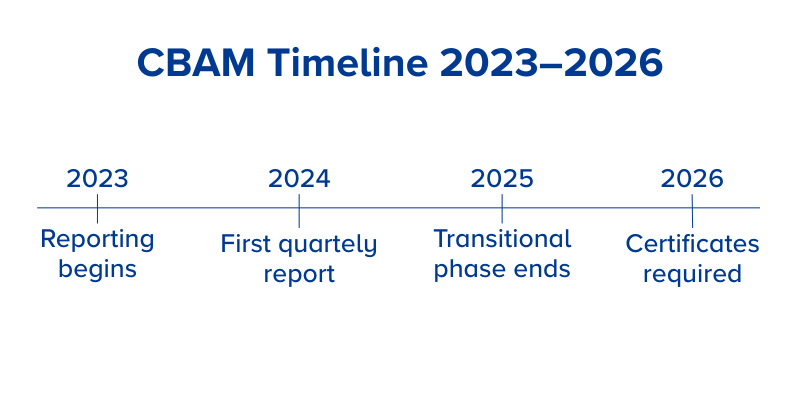What is the EU Carbon Border Adjustment Mechanism (CBAM)?
The Carbon Border Adjustment Mechanism (CBAM) is an EU initiative designed to equalise the price of carbon across its external borders. CBAM is intended to combat carbon leakage, which occurs when companies relocate production to countries with lower carbon costs, undermining global emissions reduction efforts.
CBAM promotes cleaner industrial production by establishing a standardised emissions calculation methodology aligned with the Paris Agreement and the EU Fit for 55 package. This ensures fair competition between EU and non-EU producers while incentivising low-carbon technologies.
It further encourages cleaner production in non-EU countries by making carbon-intensive exports to the EU more costly. To stay competitive, foreign manufacturers will be motivated to reduce emissions, invest in renewables, and adopt low-carbon technologies.

CBAM timeline
The Transitional Phase (2023-2025) allows importers to report carbon emissions without financial penalties, helping them adapt to CBAM regulations. Businesses must register with their National CBAM Competent Authority (NCA) and submit quarterly emissions reports, with the first due January 31, 2024.
In 2026, CBAM enters Full Implementation, requiring importers to purchase CBAM certificates, which are priced based on the carbon price in the EU Emissions Trading System (ETS). The CBAM report must be submitted quarterly and should include the total quantity of goods imported, the embedded direct and indirect emissions, and the carbon price paid in the country of origin.
CBAM changes under the EU Omnibus
The EU’s 2025 Omnibus introduces targeted adjustments to CBAM:
- De minimis exemption: Importers bringing in less than 50 tonnes per year of CBAM-covered goods will be exempt from reporting obligations. This removes compliance requirements for around 90% of importers while still covering over 99% of embedded emissions.
- Simplified compliance: The Omnibus proposes simplified reporting processes, clearer emissions calculation rules, and faster authorisation procedures for CBAM declarants.
- Regulatory alignment: The updates also reflect the EU’s broader move toward consistent and coherent sustainability regulation across frameworks like CSRD (Corporate Sustainability Reporting Directive) and the EU Taxonomy.
These changes aim to reduce administrative burden while maintaining the environmental scope of CBAM. Implementation remains scheduled for 2026.
Key CBAM terms
Understanding CBAM terminology is crucial for compliance. Below are some essential definitions:
Direct emissions: Emissions directly produced by manufacturing processes.
Embedded emissions: Includes both direct and indirect emissions, such as energy consumption.
Actual emissions: Emissions calculated based on primary data from production.
Each of these measures plays a key role in determining the CBAM certificates businesses must buy and surrender, which directly impacts their cost structure and competitiveness in the EU market.
CBAM goods
CBAM classifies imported goods into two categories:
Simple goods: Products without embedded emissions from input materials.
Complex goods: Goods produced using precursor materials with associated emissions.
Emission reporting obligations vary depending on whether a product falls under the simple or complex category.
Strategic implications for businesses
As CBAM moves from its transitional phase into full implementation in 2026, businesses should:
- Develop internal reporting systems to ensure compliance
- Evaluate supply chain emissions to minimise cost impact
- Stay informed on evolving regulations and carbon pricing mechanisms
- Consider low-carbon supply chain strategies to reduce costs
Businesses that proactively prepare for compliance will be better positioned to navigate the new regulatory landscape. Keeping up with emissions reporting requirements, classification rules, and strategic implications will be crucial in adapting to this transformative EU initiative.
ClimatePartner’s free academies and deep dives cover all things climate action, including regulatory compliance. Find your next session today!